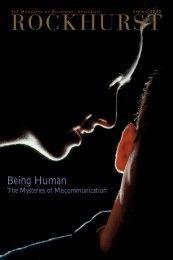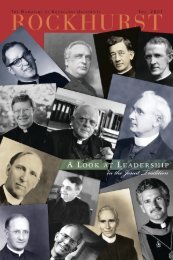Meet the President - Rockhurst University
Meet the President - Rockhurst University
Meet the President - Rockhurst University
- No tags were found...
Create successful ePaper yourself
Turn your PDF publications into a flip-book with our unique Google optimized e-Paper software.
The fact that many Americanshave come to visualize white imagerythroughout <strong>the</strong> Bible is <strong>the</strong> result ofperceptions that have been created— deliberately and o<strong>the</strong>rwise — andperpetuated throughout history.On one hand, it’s a human tendencyfor people to project <strong>the</strong>ir ownimages and worldview on to <strong>the</strong>irreligions, and <strong>the</strong>se religions giveauthority to <strong>the</strong> social hierarchies andboundaries that people create. “Thehistory of any monarchy grows out ofthis idea … that God sanctions thisfamily,” says Prentiss, who specializesin American religious history. “It’salmost like a Rorschach test, whereour image of Jesus tells us as muchabout ourselves as it does about him.”1 RockhuRst4spRinG 2006Early Christian history wasn’t limitedto Europe as many people perceive,but it was also in Africa and even Asia.Because Nor<strong>the</strong>rn African Christianitywas separated from <strong>the</strong> bulk of <strong>the</strong>Christian population for so long, thatconnection was lost, and <strong>the</strong> Christianimagery that developed in Europefound its way to <strong>the</strong> United States.Likewise, <strong>the</strong> distortion is oppositein Ethiopia, where, Stramarasays, fair-skinned whites are seen asa minority in Christian history from<strong>the</strong>ir perspective. Although he noticedEthiopians seem to be more culturallysensitive in religious artworkby painting people with a variety ofbrown skin tones, those with verylight skin tones are all but absent.Stramara visited many holy and historical sites throughout ethiopia.this monk stands outside <strong>the</strong> church that houses <strong>the</strong> ark of <strong>the</strong> Covenant.Religious artwork in ethiopia portraysfigures with a variety of skin tones.On <strong>the</strong> o<strong>the</strong>r hand, <strong>the</strong> entirecause of this disparity cannot be dismissedas innocent human nature. InAmerican history, <strong>the</strong> curse of Hamhas been used to validate whites’superiority over blacks. “The Biblehas been twisted to oppress AfricanAmericans,” says Stramara. “Butblacks have just as much claim toearly Christianity as anyone else.”By <strong>the</strong> fourth century, Christianitystretched from Britain to WesternChina, and from Nor<strong>the</strong>rn Europe tosub-Saharan Africa.So does <strong>the</strong> color of Jesus’ skinreally matter?“It has real social impact because itaffects how we treat each o<strong>the</strong>r,” saysPrentiss. “It matters in <strong>the</strong> context ofa Western culture that’s dominated byEuropeans where you create a socialhierarchy. We work toward a morejust society by realizing we’re not <strong>the</strong>center of <strong>the</strong> universe.”Just as it has taken time for <strong>the</strong>church’s efforts to use inclusive languagein <strong>the</strong> liturgy, Stramara says,it will take time for people to understandand appreciate <strong>the</strong> African rootsof <strong>the</strong> Bible and Christianity.For now, Stramara says he hopeshis experiences in Ethiopia will helphis students recognize that placessuch as Ethiopia have an unbrokenlink to <strong>the</strong> early church and that<strong>the</strong>re are a variety of valid ways toapproach God and interpret <strong>the</strong> Bible.
















